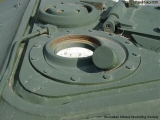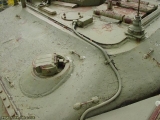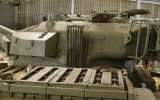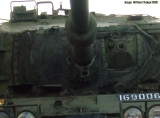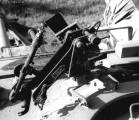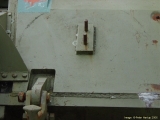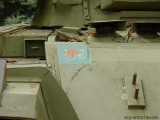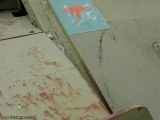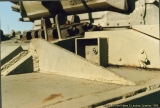…and in Vietnam too!
Background
The release of the AFV Club Royal Australian Armoured Corps Centurion Mk 5/1 (Vietnam Version) has been a wish fulfilled for many modellers, worldwide. We understand that this is the first in a large range of Centurion variants to be released by AFV Club, in both mainstream, full production and limited edition versions.
Therefore it is worthwhile to give an overview of Centurion gun tank variants, then drill down to put the Australian versions in context, and further, to see just what makes an Australian Vietnam variant – with lots of reference images, of course.
The Centurion Family
The Centurion tank provided the basis for a wide range of specialist vehicles (eg Armoured recovery vehicles, AVRE, bridgelayer, dozer tanks) produced “officially” in the UK, plus an even wider range of variants using either unique combinations of the standard enhancements (as in the Australian Centurions), or almost total rebuilds and upgrades using components sourced in the user country or from third countries (eg Israeli Sho’t, South African Olifant).
This overview will concern itself with the Centurion gun tanks. There were two marks of Centurion gun tanks which were produced prior to the definitive Mark 3 version, the Marks I (100 built) and II (250 built). Some of the references mention a slightly longer hull used for some (relatively few) Mark II vehicles, but we will exclude this hull type from our consideration of hull configuration, which leaves us with two.
Although the Centurion gun tanks ran through nominally 13 major Marks (from Mark I to Mark 13, excluding sub-types such as 5/1 etc), the situation is less daunting (if no less confusing) when one considers that determination of Centurion Marks revolves around the presence (or absence) of the following major features:
- Hulls: Two hull configurations from Mk 3 onwards. The Mark 7 hull was lengthened to provide additional internal fuel capacity.
- Main Armament: 3 types – 17 Pounder (76.2mm), 20 Pounder (83.4mm) and 105mm. The 20 Pdr main armament came in two major variants, Type A (smooth barrel) and Type B (with fume extractor).
- Co-axial MG: Initially the Besa (7.92mm) used throughout the War in British tanks, and subsequently the Browning .30 cal (7.62mm). See below for images.
- Ranging MG: Browning .50 cal (12.7mm) mounted in addition to the .30 co-ax in a modified cradle and modified mantlet. See below for comparison images.
- Up-Armouring: Most noticeably, an additional armour plate welded to the glacis plate.
- Infra-Red Capability: Most noticeably, a searchlight mounted on the turret above the main armament slightly to the LHS of the main armament’s centre line. A separate basket was fitted to the turret rear to house the searchlight when not fitted. See below for images.
- Improved Mantlet & Commander’s Cupola: Extra armour protection on the mantlet and contra rotating cupola.
- Long Range External Armoured Fuel Tank: Armoured tank with 100 gallon capacity bolted to the rear plate of the hull. Necessitated relocation of fixtures such as infantry phone to the LHS of the tank, and of the towing cable shackle to the same position on the rear plate of the fuel tank. See below for images.
These various combinations boil down to two main groups of variants based on hull type (the initial production Mark 3 hull and extended Mark 7 hull), with one “sub-group” under the Mark 7 variants based on the Improved Mantlet and Cupola which was introduced with the Mark 8 model. This can be summarised as follows:
| Group | Marks |
| Mark 3 Hulls | Mark 3, Mark 5, Mark 5/1, Mark 5/2, Mark 5/3, Mark 6, Mark 6/1, Mark 6/2, Mark 11 |
| Mark 7 Hulls | Initial Mantlet & Cupola: Mark 7, Mark 7/1, Mark 7/2, Mark 9, Mark 12 |
| Improved Mantlet and Cupola: Mark 8, Mark 8/1, Mark 8/2, Mark 10, Mark 10/1, Mark 10/2, Mark 13 |
Australian Centurion gun tanks were based exclusively on the Mark 3 hull.
Turrets
The turret used on the Mark I was unique to that mark, and its body was fabricated from cast and welded flat plate components. The turret mounted on the Mark II had a completely cast body with welded top plate and was used, with detail variations, for the rest of Centurion gun tank production. Apart from the resilient features embodied in mantlets introduced with the Mark 8, the turret structure and fittings played no role in determination of Marks. Apart from the change from Mark I to Mark II, Centurion turrets varied remarkably litte over their long service life, especially considering they absorbed two upgrades to main armament. Three main turret variants have been identified:
| Type | Identifying Features |
| Early | Rear hatch. |
| Heavy cast lip around turret roof forming deep recess around welded top plate. | |
| Combined loader’s periscope and bomb thrower in top plate. | |
| Loader’s hatch at angle to side of top plate. | |
| Base of commander’s cupola flattened on one side to allow clearance for loader’s hatch. Look closely in the background of this image!! ARN 169017. | |
| Drawing / pattern number 31364T cast into left side of turret forward of and above the ammo loading port. | |
| Mid | Rear hatch deleted. |
| Heavy cast lip eliminated surrounding turret roof plate eliminated (except at front of turret), resulting in roof plate welded in place raised above the line of the cast turret sides. | |
| Loader’s hatch reoriented to be parallel to the side of the turret roof plate. ARN 169031 | |
|
•Bomb thrower retained as separate fitting in original position, sometimes blanked over. •Loader’s periscope relocated from the roof plate to the forward sloping portion of the roof on the cast part of the turret body. •Blanking over of over-pressure valve and retention of armoured collar. |
|
| Drawing / pattern number 39887T cast into left side of turret forward of ammo loading port. | |
| Late | Incorporated changes noted above for Mid production turrets, in addition to the changes and variations noted below. |
| Elimination of bomb thrower and opening in roof plate. ARN 169080 | |
| Replacement of over pressure valve and surrounding armoured ring with circular blanking plate. Aperture has been seen used for connection to IR searchlight when fitted. ARN 169080 | |
| Drawing / pattern number 40796T cast into left side of turret above ammo loading port. ARN 169080 |
The above information has been based on information from Lovell, “Military Briefs 3” (see References below), and on analysis of images posted on this site. Shane Lovell, in the posting on Missing-Lynx under reference identifies a fourth group – Transition production between Early and Mid production. There is some evidence of this in images on this site of the turret on Centurion 169090 (refer separate Walkaround on this site) auctioned recently in Melbourne (see separate Feature on this site), which has the following features:
| Loaders hatch with early orientation and shape. Does not appear from this and other images to have repositioned loader’s periscope. ARN 169090 |
| BUT, no evidence of rear hatch (no heavy hinges visible). |
| Drawing / casting number similar to 39887T identified in Lovell, but last two digits do not appear to be 87. |
Also, it should be noted that the drawing / pattern numbers indicated above differ from those given in Shane’s post, based on the photographic evidence of definitely early and late production turrets elsewhere on this site.
In settling upon this classification structure of four elements (Early, Mid, Late and Transition) the distinguishing characteristics have been the apertures in the fabric of the turret and top plate rather than what’s been mounted in those apertures. Therefore, the presence of an aperture for an early bomb-thrower and a repositioned loader’s periscope is more important / indicative of turret type than whether the bomb-thrower is present or the aperture blanked over.
A Guide to Centurion Marks
The following table (based on information from Orsbourn and Beldham – see References below) illustrates the various combinations of the features (hull / armament / up-armouring etc) identified which distinguish the standard Marks of Centurion gun tanks:
| Marks | Armament (Main) | Armament (Secondary) | Other | Comment | ||||||||
| 17 Pdr |
20 Pdr |
105 mm |
Besa | .30 Coax |
.50 RMG |
.30 Cmdr |
Up- Armour |
Infra- Red |
Mantlet/ Cupola |
LR Fuel |
||
| Mk I | X | X | Meteor Mk 4 | |||||||||
| Mk II | X | X | Meteor Mk 4A | |||||||||
| Initial Production Hull | ||||||||||||
| Mk 3 | X | X | Meteor Mk 4B | |||||||||
| Mk 5 | X | X | Upgraded Mk 3 | |||||||||
| Mk 5/1 | X | X | X | Upgraded Mk 5 | ||||||||
| Mk 5/2 | X | X | Upgraded Mk 5 | |||||||||
| Mk 5/3 | X | X | X | Upgraded Mk 5 | ||||||||
| Mk 6 | X | X | X | Upgraded Mk 5 | ||||||||
| Mk 6/1 | X | X | X | X | Upgraded Mk 6 | |||||||
| Mk 6/2 | X | X | X | X | Upgraded Mk 6 | |||||||
| Mk 11 | X | X | X | X | X | Upgraded Mk 5 | ||||||
| Lengthened Hull | ||||||||||||
| Mk 7 | X | X | New hull | |||||||||
| Mk 7/1 | X | X | X | Upgraded Mk 7 | ||||||||
| Mk 7/2 | X | X | Upgraded Mk 7 | |||||||||
| Mk 9 | X | X | X | Only one built | ||||||||
| Mk 9/1 | X | X | X | X | Upgraded Mk 7 | |||||||
| Mk 9/2 | X | X | X | X | Upgraded Mk 7 | |||||||
| Mk 12 | X | X | X | X | X | Upgraded Mk 7 | ||||||
| Mk 8 | X | X | X | New mantlet/cupola | ||||||||
| Mk 8/1 | X | X | X | X | Upgraded Mk 8 | |||||||
| Mk 8/2 | X | X | X | Upgraded Mk 8 | ||||||||
| Mk 10 | X | X | X | X | Upgraded Mk 8 | |||||||
| Mk 10/1 | X | X | X | X | X | Upgraded Mk 8 | ||||||
| Mk 10/2 | X | X | X | X | X | Upgraded Mk 8 | ||||||
| Mk 13 | X | X | X | X | X | Upgraded Mk 8 | ||||||
| Australian Centurions (South Vietnam) | ||||||||||||
| Mk 3 | X | X | X | X | X | X | X | |||||
| Mk 5/1 | X | X | X | X | X | X | X | |||||
As can be seen from this table, with the exception of main armament, the full Australian SVN configuration corresponded broadly with a “standard” Mark 11.
Australian Centurions
We now come to the minefield of Australian Centurions.
Australia’s Centurion fleet was acquired in a number of batches, direct from the factory and “used” from British storage in Hong Kong (10 Mk 5) and from New Zealand (8 gun tanks, 1 ARV Mk 1). The following table (from Lovell, Military Briefs 3 – see References below) sets out the “factory” purchases:
| Mark | No | Delivery Year | ARN Range |
|---|---|---|---|
| Mark 3 | 60 | 1951/52 | 169000-169059 |
| Mark 5 | 51 | 1955/56 | 169060-169110 |
| Mark 2 ARV | 4 | 1955/56 | 169111-169114 |
| Mark 5 | 6 | 1956/57 | 169115-169020 |
| Mark 2 ARV | 2 | 1956/57 | 169121-169122 |
| Mark 5 Bridgelayers | 4 | 1960/61 | 115541-115544 |
| Total Gun Tanks | 117 | ||
| Total Support | 10 |
The first thing to note is that all Mark 3’s delivered were upgraded to Mark 5 (ie 20 Pdr main armament with the Browning .30 cal co-axial MG). Beyond this, configurations can be a bit conditional!
Over time, and as a matter of policy even prior to the deployment to South Vietnam (SVN), vehicles were rotated back to the Base Workshop in Bandiana based on mileage in use for complete rebuild and fitting of all currently authorised modifications. Refurbished vehicles were then placed into storage pending authorisation for issue to units as replacements for other vehicles entering into the rebuild program. As a result of this policy, the first vehicles deployed to SVN sported the following enhancements:
Browning .50 cal ranging machine gun (RMG) fitted. This modification involved:
|
Straight Mark 5 mantlet and co-ax mounting. ARN 169090. |
| ARN 169006 with RMG mount. | |
| Enlargement of RMG area on ARN 169006. | |
| Enlargement of RMG area on ARN 169072 – no canvas cover on mantlet. | |
Long range armoured fuel tank mounted on rear plate. This necessitated:
|
Bridgelayers ARN 115541 and ARN 115544 showing direct comparison of rear fittings with and without external fuel tank mounted. |
| Fuel tank mount on ARN 169090 – no infantry telephone fitted, mounts to fuel tank exposed. | |
| Fuel tank with infantry phone fitted. | |
| Fuel tank with infantry phone fitted – view from above. | |
Infra-red (IR)capability including:
|
Searchlight fitting on ARN 169017. |
| Side view of searchlight and mounts (ARN 169017). | |
| Turret basket for searchlight when not in use (ARN 169017). | |
| Commander’s .30cal Browning machine gun fitted to cupola, including clip mounts for the MG at the rear of the turret roof when not in use. | Mount for commander’s MG. |
| Clip mounts for commander’s MG when not in use. | |
| Up-armouring of glacis. | Original glacis of ARV 169111 without up-armouring. |
| Glacis of ARN 169080 with up-armouring. | |
| Note cutout at top of plate to preserve driver’s view. ARN 169080 | |
| ARN 169080 | |
| ARN 169080 | |
| ARN 169080 |
SVN Modifications
Centurions deployed to Vietnam had generally, as a minimum, the .50 cal ranging machine gun (RMG) and up-armouring upgrades, making them broadly equivalent (again, with the exception of the main armament) to a standard Mark 6/2. This configuration has sometimes been referred to as Mark 5/1 (Aust). IR suites were mounted in the majority of, but not necessarily all, cases. In addition a number of other externally visible enhancements were made in the light of experience over time, and progressively fitted as individual vehicles underwent regular servicing:
|
|
|
ARN 169090 |
| ARN 169031 | |
| ARN 169031 | |
|
Initially, not all racks included the small holder for an infantry PRC25 radio visible in this image, this being confined to control tanks. However, experience soon saw this useful innovation being incorporated on all vehicles. ARN 169031 |
| ARN 169080 | |
| ARN 169080 | |
|
ARN 169017 |
| ARN 169017 | |
| ARN 169017 | |
| ARN 169017 | |
|
ARN 169017 |
| ARN 169017 | |
| ARN 169017 | |
| ARN 169017 | |
|
ARN 169108 |
|
ARN 169108 |
| ARN 169108 |
A full treatment of modifications, including timeframes, can be found in Lovell (see References below).
After Vietnam
An important point to note is that after Vietnam, the Centurion fleet was returned progressively to a “standardised” state, with most of the Vietnam-specific modifications noted above being removed over the remaining time that the Centurion was to remain in Australian service prior to introduction of Leopard. Rebuilds and base overhauls continued into the 1980s as Leopard was phased into service. Many vehicles currently in private hands came from war stocks. Once Leopard started coming into service, there was, understandably, less interest in keeping these vehicles up to date, with the result that replacement parts were often sourced from what was at hand, including nominally “obsolete” components and assemblies which had been previously upgraded. Accordingly, care must be taken when using reference from surviving vehicles.
A case in point is Centurion ARN 169090, which is featured on this site in a separate Walkaround and was sold at the recent Melbourne Tank Museum auction. There is no doubt that this vehicle served in SVN. There is also no doubt that available documentation (official and otherwise) confirms that it was fitted with the RMG upgrade, yet our images from the auction clearly show the vehicle with a “straight” Mk 3/ Mk 5 mantlet (ie no RMG, no separate aperture for the .30 cal coax MG). Perhaps it is reasonable in this case to speculate that with the decision (either pending, or just made) to replace the Centurions in Australian service with Leopard at around the same time that the RAAC and their Centurions returned from Vietnam, replacement of defective or old parts was made from whatever spare components were at hand.
Another suggested possibility is that this chassis was fitted with one of the earlier model turrets from one of the Centurions acquired from New Zealand.
Conclusion
We hope that these brief notes will help placing the sometimes confusing subject of Centurion gun tanks into some type of basic framework.
In preparing this feature many knowledgeable people have assisted immeasurably by reviewing early drafts and providing very useful information, in particular Paul Handel, Shane Lovell and Al Bowie. In the case of Shane Lovell, his generosity extended to the provision of several useful images, and a bibliography which will form the basis of another feature.
Any and all remaining errors are therefore my own!
The following references were invaluable in pulling together this overview:
- Shane Lovell, “Military Briefs 3: Australian Centurions in Vietnam”, Mouse House Enterprises, 2002. This valuable reference has been reprinted recently is is available from the publishers direct.
- Shane Lovell & Ossie Orsbourn, Posts on Missing-Lynx 14 June 2006 and 27 January 2005, respectively.
- Col Filtness’ excellent Australian Centurion pages Battletank and Steel Thunder. These pages document Col’s search for surviving Australian Centurions and include many useful contemporary images of Centurions in service in South Vietnam.
- Barry Beldham, “The Serious Modeller’s Guide to Canadian Centurion Gun Tanks”, distributed by Quartermaster’s Depot though I bought mine locally at Battlebridge Military Books here in Sydney.





